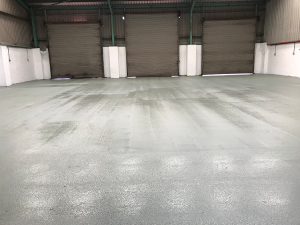Floor Coatings FAQ, Regal Paints FAQs
Floor Painting Issues FAQ
We have listed and explained the most common floor painting issues that we have come across over the years. These are industry-wide problems and so are issues that you may have with any floor that you may have painted with paint from any manufacturer….the problem is not always the paint!
My floor is not drying
We quality control and batch test all our products prior to decanting into cans and sending to our customers. If you are experiencing drying issues with your floor paint, please call us on 01782 550733 and speak to our technical team.
I have used two-pack epoxy paint and now have white patches on my floor
White marks on an epoxy floor are due to amine blush/blooming. These floor painting issues occur when moisture is in contact with the coating as it is being applied or before it is properly cured. This can be due to excessive humidity, condensation and/or applying the product too thickly. If your floor has white amine blush, it can usually be removed by mopping with a 50:50 solution of citric acid and warm water. For more information, read our post on amine blush and amine bloom.
There are pinholes in the paint
Pinholes and bubbling on an epoxy floor paint coated floor appear as small blisters or bubbles. After the blisters pop, they leave a round crater and the pinhole can be seen in the finish of the paint. The causes of pinholes in an epoxy paint are usually caused by ‘outgassing’ – this is where air trapped in concrete voids reacts when fresh epoxy paint begins its curing or exothermal action. The chemical reaction creates heat. This releases moisture into the air pocket making the air within it expand. This naturally forces air to escape from the pore and towards the surface where it and becomes trapped in the coating and then either forms a blister or pops to leave a pinhole.
There are other floor painting issues which may cause pinholes to appear; these include: –
- Temperature/Humidity: If it is too hot or humid, it can result in rapid drying which causes air entrapment in the coating.
- Air Movement: Air movement from fans, door or vents blowing directly on the surface may cause flash drying. This may cause bubbles which pop to leave pinholes.
- Sunlight: Direct sunlight can cause the product to become tacky before necessary air release has occurred, which results in bubbles.
- Mixing: Mixing at too high of a speed entraps air, resulting in bubbles.
- Surface Preparation: Very extreme or aggressive shot-blasting opens the pores in the concrete causing air to be trapped when the coating is applied and this may result in bubbles.
- Roller Sleeves: Not using the recommended floor roller-sleeves.
I have driven my car into the garage and pieces of paint have come off the floor
This floor painting issue can effect garages painted with garage floor paint if straightforward precautions are not taken and is known as hot-tyre pick-up. Please see our blog post.
Other articles on floor painting related questions
Floor Painting Issues FAQ
We have listed and explained the most common issues that we have come across over the years. These are industry-wide problems and so are issues that you may have with [...]
Floor Preparation Advice FAQ
To ensure that you achieve the maximum level of adherence between the paint and the substrate, and therefore a long-lasting finish, how do you prepare a floor for painting? Here [...]
Single Pack Floor Paint Systems FAQ
Single Pack Floor System - Our popular single pack paint system will give you a long-lasting and quality finish to your floor. Here we answer the most commonly asked questions, [...]
Two-Pack Epoxy Floor Paint Systems FAQ
Two-Pack Epoxy Floor Paint - Epoxy is our most hard-wearing and durable floor coating. There are several questions that we are frequently asked by our customer. Here we try to [...]
Floor Paint Systems FAQ
Floor Paint Systems - Did you know that you need to use a compatible primer and topcoat when painting a floor? Unsure what a floor-paint system is? Our compatible products [...]
Priming a Floor FAQ
Priming a Floor - You may have many questions about the benefits of priming a floor.Do you really need to use a primer? And Why? We answer those questions for [...]







